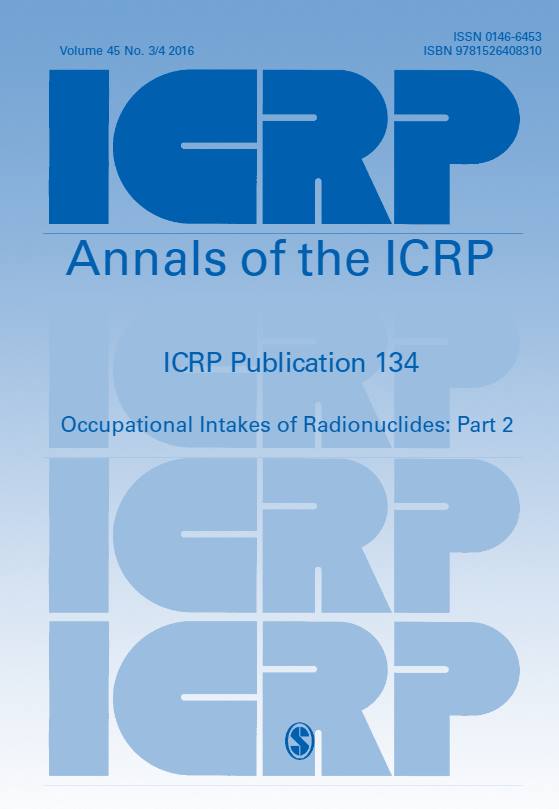ICRP Publication 134
Occupational Intakes of Radionuclides: Part 2
Recommended citation
ICRP, 2016. Occupational Intakes of Radionuclides: Part 2. ICRP Publication 134. Ann. ICRP 45(3/4), 1–352.
Authors on behalf of ICRP
F. Paquet, M.R. Bailey, R.W. Leggett, J. Lipsztein, T.P. Fell,T. Smith, D. Nosske, K.F. Eckerman, V. Berkovski, E. Ansoborlo,A. Giussani, W.E. Bolch, J.D. Harrison
Abstract - The 2007 Recommendations of the International Commission on Radiological Protection (ICRP, 2007) introduced changes that affect the calculation of effective dose, and implied a revision of the dose coefficients for internal exposure, published previously in thePublication 30series (ICRP, 1979, 1980, 1981, 1988b) and Publication 68(ICRP, 1994b). In addition, new data are available that support an update of the radionuclide-specific information given in Publications 54 and 78 (ICRP, 1988a, 1997b) for the design of monitoring programmes and retrospective assessment of occupational internal doses. Provision of new biokinetic models, dosecoefficients, monitoring methods, and bioassay data was performed by Committee 2, Task Group 21 on Internal Dosimetry, and Task Group 4 on Dose Calculations. A new series, the Occupational Intakes of Radionuclides (OIR) series, will replace the Publication 30series and Publications 54,68, and 78. Part 1 of the OIR series has been issued (ICRP, 2015), and describes the assessment of internal occupational exposure to radionuclides, biokinetic and dosimetric models, methods of individual and workplace monitoring, and general aspects of retrospective dose assessment. The following publications in the OIR series (Parts 2–5) will provide data on individual elements and their radioisotopes, including information on chemical forms encountered in the workplace; a list of principal radioisotopes and their physical half-lives and decay modes; the parameter values of the reference biokinetic model; and data on monitoring techniques for the radioisotopes encountered most commonly in workplaces. Reviews of data on inhalation, ingestion, and systemic biokinetics are also provided for most of the elements. Dosimetric data provided in the printed publications of the OIR series include tables of committed effective dose perintake (Sv per Bq intake) for inhalation and ingestion, tables of committed effective dose per content (Sv per Bq measurement) for inhalation, and graphs of retentionand excretion data per Bq intake for inhalation. These data are provided for all absorption types and for the most common isotope(s) of each element. The electronic annex that accompanies the OIR series of reports contains a comprehensive set of committed effective and equivalent dose coefficients, committed effective dose percontent functions, and reference bioassay functions. Data are provided for inhalation, ingestion, and direct input to blood. The present publication provides the above data for the following elements: hydrogen (H), carbon (C), phosphorus (P),sulphur (S), calcium (Ca), iron (Fe), cobalt (Co), zinc (Zn), strontium (Sr), yttrium(Y), zirconium (Zr), niobium (Nb), molybdenum (Mo), and technetium (Tc).
ICRP, 2016. Occupational Intakes of Radionuclides: Part 2. ICRP Publication 134. Ann. ICRP 45(3/4), 1–352.
Authors on behalf of ICRP
F. Paquet, M.R. Bailey, R.W. Leggett, J. Lipsztein, T.P. Fell,T. Smith, D. Nosske, K.F. Eckerman, V. Berkovski, E. Ansoborlo,A. Giussani, W.E. Bolch, J.D. Harrison
Abstract - The 2007 Recommendations of the International Commission on Radiological Protection (ICRP, 2007) introduced changes that affect the calculation of effective dose, and implied a revision of the dose coefficients for internal exposure, published previously in thePublication 30series (ICRP, 1979, 1980, 1981, 1988b) and Publication 68(ICRP, 1994b). In addition, new data are available that support an update of the radionuclide-specific information given in Publications 54 and 78 (ICRP, 1988a, 1997b) for the design of monitoring programmes and retrospective assessment of occupational internal doses. Provision of new biokinetic models, dosecoefficients, monitoring methods, and bioassay data was performed by Committee 2, Task Group 21 on Internal Dosimetry, and Task Group 4 on Dose Calculations. A new series, the Occupational Intakes of Radionuclides (OIR) series, will replace the Publication 30series and Publications 54,68, and 78. Part 1 of the OIR series has been issued (ICRP, 2015), and describes the assessment of internal occupational exposure to radionuclides, biokinetic and dosimetric models, methods of individual and workplace monitoring, and general aspects of retrospective dose assessment. The following publications in the OIR series (Parts 2–5) will provide data on individual elements and their radioisotopes, including information on chemical forms encountered in the workplace; a list of principal radioisotopes and their physical half-lives and decay modes; the parameter values of the reference biokinetic model; and data on monitoring techniques for the radioisotopes encountered most commonly in workplaces. Reviews of data on inhalation, ingestion, and systemic biokinetics are also provided for most of the elements. Dosimetric data provided in the printed publications of the OIR series include tables of committed effective dose perintake (Sv per Bq intake) for inhalation and ingestion, tables of committed effective dose per content (Sv per Bq measurement) for inhalation, and graphs of retentionand excretion data per Bq intake for inhalation. These data are provided for all absorption types and for the most common isotope(s) of each element. The electronic annex that accompanies the OIR series of reports contains a comprehensive set of committed effective and equivalent dose coefficients, committed effective dose percontent functions, and reference bioassay functions. Data are provided for inhalation, ingestion, and direct input to blood. The present publication provides the above data for the following elements: hydrogen (H), carbon (C), phosphorus (P),sulphur (S), calcium (Ca), iron (Fe), cobalt (Co), zinc (Zn), strontium (Sr), yttrium(Y), zirconium (Zr), niobium (Nb), molybdenum (Mo), and technetium (Tc).
